Deck 8: Producers in the Long Run
Question
Question
Question
Question
Question
Question
Question
Question
Question
Question
Question
Question
Question
Question
Question
Question
Question
Question
Question
Question
Question
Question
Question
Question
Question
Question
Question
Question
Question
Question
Question
Question
Question
Question
Question
Question
Question
Question
Question
Question
Question
Question
Question
Question
Question
Question
Question
Question
Question
Question
Question
Question
Question
Question
Question
Question
Question
Question
Question
Question
Question
Question
Question
Question
Question
Question
Question
Question
Question
Question
Question
Question
Question
Question
Question
Question
Question
Question
Question
Question

Unlock Deck
Sign up to unlock the cards in this deck!
Unlock Deck
Unlock Deck
1/127
Play
Full screen (f)
Deck 8: Producers in the Long Run
1
The figure below shows the isocost lines and the isoquant map for a firm producing golf tees.
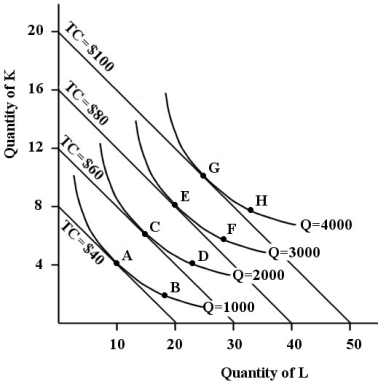 FIGURE 8- 6
FIGURE 8- 6
Refer to Figure 8- 6.Suppose this firm is producing 3000 golf tees and is at point F on the isoquant map.Which of the following is true?
A)MPK/MPL is greater than 5/2.
B)MPK/MPL is equal to PK/PL .
C)MPK/MPL is equal to 2/5.
D)MPL/MPK is greater than 5/2.
E)MPK/MPL is equal to 5/2.
 FIGURE 8- 6
FIGURE 8- 6Refer to Figure 8- 6.Suppose this firm is producing 3000 golf tees and is at point F on the isoquant map.Which of the following is true?
A)MPK/MPL is greater than 5/2.
B)MPK/MPL is equal to PK/PL .
C)MPK/MPL is equal to 2/5.
D)MPL/MPK is greater than 5/2.
E)MPK/MPL is equal to 5/2.
A
2
The slope of an isoquant measures
A)the average capital/labour ratio.
B)the ratio of prices of goods.
C)the ratio of prices of inputs.
D)the marginal rate of (technical)substitution between factors.
E)the marginal cost of a given level of output.
A)the average capital/labour ratio.
B)the ratio of prices of goods.
C)the ratio of prices of inputs.
D)the marginal rate of (technical)substitution between factors.
E)the marginal cost of a given level of output.
D
3
Which of the following conditions indicate cost minimization,assuming two inputs,labour (L)and capital (K)?
A)MPL = MPK
B)MPK/PL = MPL/PK
C)MPK/PK = MPL/PL
D)PK = PL
E)PK · MPK = PL · MPL
A)MPL = MPK
B)MPK/PL = MPL/PK
C)MPK/PK = MPL/PL
D)PK = PL
E)PK · MPK = PL · MPL
C
4
The figure below shows the isocost lines facing a firm producing golf tees.
 FIGURE 8- 5
FIGURE 8- 5
Refer to Figure 8- 5.This firm can be a "cost minimizer" by producing on isocost line
A)1 only.
B)2 only.
C)3 only.
D)4 only.
E)Not able to determine from the information provided.
 FIGURE 8- 5
FIGURE 8- 5Refer to Figure 8- 5.This firm can be a "cost minimizer" by producing on isocost line
A)1 only.
B)2 only.
C)3 only.
D)4 only.
E)Not able to determine from the information provided.

Unlock Deck
Unlock for access to all 127 flashcards in this deck.
Unlock Deck
k this deck
5
The table below shows the number of units of labour and capital used in 4 alternative production techniques for producing 1000 widgets per month. TABLE 8- 1
-Refer to Table 8- 1.Which production technique is obviously technically inefficient?
A)A
B)B
C)C
D)D
E)All four techniques are inefficient.
-Refer to Table 8- 1.Which production technique is obviously technically inefficient?
A)A
B)B
C)C
D)D
E)All four techniques are inefficient.

Unlock Deck
Unlock for access to all 127 flashcards in this deck.
Unlock Deck
k this deck
6
The slope of a firm's isocost line is equal to the ratio of
A)the factor prices.
B)the marginal rate of substitution between factors.
C)the marginal products of its factors.
D)product prices.
E)total variable cost to total cost.
A)the factor prices.
B)the marginal rate of substitution between factors.
C)the marginal products of its factors.
D)product prices.
E)total variable cost to total cost.

Unlock Deck
Unlock for access to all 127 flashcards in this deck.
Unlock Deck
k this deck
7
In the long run,the law of diminishing marginal returns
A)is not relevant because there are no fixed factors of production.
B)is exactly the same as in the short run.
C)does not hold because technology is a variable.
D)does hold,regardless of production process.
E)sometimes holds,depending on the production process.
A)is not relevant because there are no fixed factors of production.
B)is exactly the same as in the short run.
C)does not hold because technology is a variable.
D)does hold,regardless of production process.
E)sometimes holds,depending on the production process.

Unlock Deck
Unlock for access to all 127 flashcards in this deck.
Unlock Deck
k this deck
8
"The bigger the volume,the lower the cost,and we pass these savings on to you" is a familiar advertising slogan.It implies essentially that the
A)firm expects to experience increasing returns over the relevant level of output.
B)firm is altruistic.
C)consumer is able to pay less today because the total cost of the firm is expected to decline tomorrow.
D)average fixed cost will decline or remain constant over the long run.
E)total cost of the firm will remain constant as output expands.
A)firm expects to experience increasing returns over the relevant level of output.
B)firm is altruistic.
C)consumer is able to pay less today because the total cost of the firm is expected to decline tomorrow.
D)average fixed cost will decline or remain constant over the long run.
E)total cost of the firm will remain constant as output expands.

Unlock Deck
Unlock for access to all 127 flashcards in this deck.
Unlock Deck
k this deck
9
The creation of a new product is called
A)a rise in productivity.
B)process innovation.
C)creative destruction.
D)investment.
E)product innovation.
A)a rise in productivity.
B)process innovation.
C)creative destruction.
D)investment.
E)product innovation.

Unlock Deck
Unlock for access to all 127 flashcards in this deck.
Unlock Deck
k this deck
10
The figure below shows a family of cost curves for a firm.The subscripts 1,2,and 3 for the SRATC curves refer to different plant sizes.
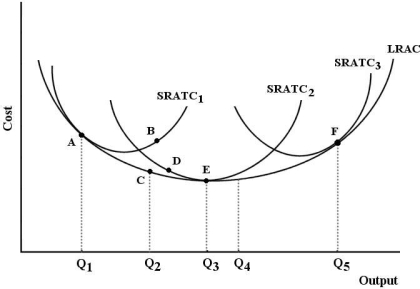 FIGURE 8- 3
FIGURE 8- 3
Refer to Figure 8- 3.The minimum efficient scale is achieved by this firm at output level
A)Q1.
B)Q2.
C)Q3.
D)Q4.
E)Q5.
 FIGURE 8- 3
FIGURE 8- 3Refer to Figure 8- 3.The minimum efficient scale is achieved by this firm at output level
A)Q1.
B)Q2.
C)Q3.
D)Q4.
E)Q5.

Unlock Deck
Unlock for access to all 127 flashcards in this deck.
Unlock Deck
k this deck
11
Consider a firm in the long run that is trying to maximize its profits.It should
A)minimize the cost of producing whatever level of output it chooses.
B)charge the lowest price possible given the minimum possible cost.
C)maximize the marginal product of all factors of production.
D)charge the highest price.
E)select the most technically efficient method of production regardless of the level of production.
A)minimize the cost of producing whatever level of output it chooses.
B)charge the lowest price possible given the minimum possible cost.
C)maximize the marginal product of all factors of production.
D)charge the highest price.
E)select the most technically efficient method of production regardless of the level of production.

Unlock Deck
Unlock for access to all 127 flashcards in this deck.
Unlock Deck
k this deck
12
Which of the following paired concepts are equivalent to each other?
A)increasing returns; decreasing costs
B)increasing returns; diseconomies of scale
C)increasing returns; increasing costs
D)constant costs; economies of scale
E)increasing costs; economies of scale
A)increasing returns; decreasing costs
B)increasing returns; diseconomies of scale
C)increasing returns; increasing costs
D)constant costs; economies of scale
E)increasing costs; economies of scale

Unlock Deck
Unlock for access to all 127 flashcards in this deck.
Unlock Deck
k this deck
13
Of the following,which is the least likely to represent a firm's long- run decision?
A)By how much should output be expanded from existing plants?
B)What technique (technology)is the best to use under current factor pricing?
C)What should be the size and design of a firm's new plant?
D)Should the firm choose a method of production that uses relatively more capital than labour?
E)Should the firm invest resources in the development of better technologies?
A)By how much should output be expanded from existing plants?
B)What technique (technology)is the best to use under current factor pricing?
C)What should be the size and design of a firm's new plant?
D)Should the firm choose a method of production that uses relatively more capital than labour?
E)Should the firm invest resources in the development of better technologies?

Unlock Deck
Unlock for access to all 127 flashcards in this deck.
Unlock Deck
k this deck
14
FIGURE 8- 4 
Refer to Figure 8- 4.A firm that is producing an output of 2000 units will minimize its costs at point
A)A.
B)B.
C)C.
D)D.
E)There is not enough information provided to be sure.

Refer to Figure 8- 4.A firm that is producing an output of 2000 units will minimize its costs at point
A)A.
B)B.
C)C.
D)D.
E)There is not enough information provided to be sure.

Unlock Deck
Unlock for access to all 127 flashcards in this deck.
Unlock Deck
k this deck
15
A very- long- run consideration that could change a firm's production function is
A)increasing returns to scale of operation.
B)size of the plant.
C)diminishing returns.
D)rising cost of the factors of production.
E)an improvement in education that increases the quality of the economy's labour force.
A)increasing returns to scale of operation.
B)size of the plant.
C)diminishing returns.
D)rising cost of the factors of production.
E)an improvement in education that increases the quality of the economy's labour force.

Unlock Deck
Unlock for access to all 127 flashcards in this deck.
Unlock Deck
k this deck
16
The figure below shows the isocost lines and the isoquant map for a firm producing golf tees.
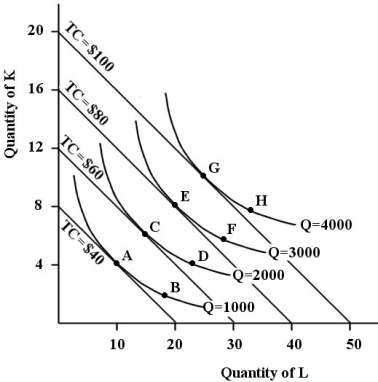 FIGURE 8- 6
FIGURE 8- 6
Refer to Figure 8- 6.Suppose this firm is producing 3000 golf tees and is at point F on the isoquant map.In order to maintain its output and minimize costs this firm should
A)move to an isoquant closer to the origin.
B)not change its use of factors.
C)employ more labour and less capital.
D)employ more capital and less labour.
E)move to an isocost line further from the origin.
 FIGURE 8- 6
FIGURE 8- 6Refer to Figure 8- 6.Suppose this firm is producing 3000 golf tees and is at point F on the isoquant map.In order to maintain its output and minimize costs this firm should
A)move to an isoquant closer to the origin.
B)not change its use of factors.
C)employ more labour and less capital.
D)employ more capital and less labour.
E)move to an isocost line further from the origin.

Unlock Deck
Unlock for access to all 127 flashcards in this deck.
Unlock Deck
k this deck
17
When there is no other way of producing a given level of output with a smaller total value of inputs,the firm is operating at
A)optimal output.
B)maximum cost.
C)maximum profit.
D)maximum output.
E)minimum cost.
A)optimal output.
B)maximum cost.
C)maximum profit.
D)maximum output.
E)minimum cost.

Unlock Deck
Unlock for access to all 127 flashcards in this deck.
Unlock Deck
k this deck
18
In the long run,a profit- maximizing firm producing a given level of output chooses the production method that
A)leads to a flat total cost curve.
B)produces that output at the lowest possible cost.
C)minimizes labour input.
D)maximizes the marginal product of all factors.
E)maximizes the marginal product of labour.
A)leads to a flat total cost curve.
B)produces that output at the lowest possible cost.
C)minimizes labour input.
D)maximizes the marginal product of all factors.
E)maximizes the marginal product of labour.

Unlock Deck
Unlock for access to all 127 flashcards in this deck.
Unlock Deck
k this deck
19
FIGURE 8- 4 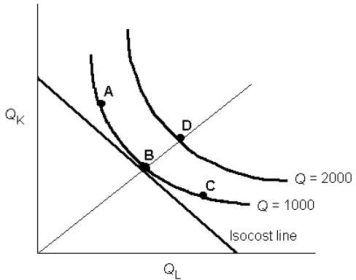
Refer to Figure 8- 4.The firm is initially producing 1000 units and minimizing its production cost at point B.Suppose the prices of capital and labour each fall by 20%.If the firm wishes to continue producing the same level of output it will
A)move toward point A.
B)remain at point B.
C)move toward point C.
D)move to the left of point B.
E)move toward point D.

Refer to Figure 8- 4.The firm is initially producing 1000 units and minimizing its production cost at point B.Suppose the prices of capital and labour each fall by 20%.If the firm wishes to continue producing the same level of output it will
A)move toward point A.
B)remain at point B.
C)move toward point C.
D)move to the left of point B.
E)move toward point D.

Unlock Deck
Unlock for access to all 127 flashcards in this deck.
Unlock Deck
k this deck
20
Economists collect and analyze data on output per worker and output per hour of work.What are they trying to measure by doing so?
A)the ratio of marginal products of factors
B)productivity
C)diminishing marginal returns
D)the principle of substitution
E)returns to scale
A)the ratio of marginal products of factors
B)productivity
C)diminishing marginal returns
D)the principle of substitution
E)returns to scale

Unlock Deck
Unlock for access to all 127 flashcards in this deck.
Unlock Deck
k this deck
21
The long- run average cost curve is an envelope curve,with each point associated with a short- run average cost curve
A)crossing that point from above.
B)intersecting that point.
C)lying below it.
D)at its minimum point.
E)tangent at that point.
A)crossing that point from above.
B)intersecting that point.
C)lying below it.
D)at its minimum point.
E)tangent at that point.

Unlock Deck
Unlock for access to all 127 flashcards in this deck.
Unlock Deck
k this deck
22
The following table shows the marginal products of capital (K)and labour (L)for various methods for Firm ABC to produce 1000 toys per day. TABLE 8- 2
-Refer to Table 8- 2.If capital costs $6 per unit and labour costs $4 per unit,which production method minimizes the cost of producing 1000 toys per day?
A)method E
B)method C
C)method B
D)method F
E)method D
-Refer to Table 8- 2.If capital costs $6 per unit and labour costs $4 per unit,which production method minimizes the cost of producing 1000 toys per day?
A)method E
B)method C
C)method B
D)method F
E)method D

Unlock Deck
Unlock for access to all 127 flashcards in this deck.
Unlock Deck
k this deck
23
Suppose that a firm is using 100 units of labour and 50 units of capital to produce 200 completed client tax returns per day.The price of labour is $10 per unit and the price of capital is $5 per unit.The MPL equals 2 and the MPK equals 5.In this situation,
A)the firm should decrease the use of both inputs.
B)the firm is minimizing its costs.
C)the firm could lower its production costs by increasing labour input and decreasing capital input.
D)the firm should increase the use of both inputs.
E)the firm could lower its production costs by decreasing labour input and increasing capital input.
A)the firm should decrease the use of both inputs.
B)the firm is minimizing its costs.
C)the firm could lower its production costs by increasing labour input and decreasing capital input.
D)the firm should increase the use of both inputs.
E)the firm could lower its production costs by decreasing labour input and increasing capital input.

Unlock Deck
Unlock for access to all 127 flashcards in this deck.
Unlock Deck
k this deck
24
In the long run,decreasing returns to scale are likely to be caused by
A)diminishing returns to the variable factor.
B)decreasing costs.
C)increasing specialization of labour.
D)a decrease in factor prices.
E)diseconomies of scale associated with management problems.
A)diminishing returns to the variable factor.
B)decreasing costs.
C)increasing specialization of labour.
D)a decrease in factor prices.
E)diseconomies of scale associated with management problems.

Unlock Deck
Unlock for access to all 127 flashcards in this deck.
Unlock Deck
k this deck
25
For a firm with only two inputs,capital and labour,the condition MPK/MPL = PK/PL guarantees that the firm is
A)at its profit- maximizing and cost- minimizing level of output.
B)minimizing its costs but is not necessarily maximizing its profits.
C)economically efficient but not technically efficient.
D)technically efficient but not economically efficient.
E)at its profit- maximizing output but is not necessarily minimizing its costs.
A)at its profit- maximizing and cost- minimizing level of output.
B)minimizing its costs but is not necessarily maximizing its profits.
C)economically efficient but not technically efficient.
D)technically efficient but not economically efficient.
E)at its profit- maximizing output but is not necessarily minimizing its costs.

Unlock Deck
Unlock for access to all 127 flashcards in this deck.
Unlock Deck
k this deck
26
Suppose Commercial Footware Inc.is making a cost- minimizing decision about the level of output to produce with a given technology.Which of the following is a long- run decision?
A)Should we invest in research for a new,improved technology for shoe production?
B)Should we change to a lower- cost leather supplier?
C)Should we hire additional labour to work in the existing facility?
D)Should we hire more accountants to investigate ways to reduce our corporate tax payments?
E)Should we build a larger shoe manufacturing facility?
A)Should we invest in research for a new,improved technology for shoe production?
B)Should we change to a lower- cost leather supplier?
C)Should we hire additional labour to work in the existing facility?
D)Should we hire more accountants to investigate ways to reduce our corporate tax payments?
E)Should we build a larger shoe manufacturing facility?

Unlock Deck
Unlock for access to all 127 flashcards in this deck.
Unlock Deck
k this deck
27
FIGURE 8- 1 
Refer to Figure 8- 1.For which of the four firms in the figure is output increasing more than in proportion to inputs for all output levels?
A)Firm A
B)Firm B
C)Firm C
D)Firm D
E)none of the four firms

Refer to Figure 8- 1.For which of the four firms in the figure is output increasing more than in proportion to inputs for all output levels?
A)Firm A
B)Firm B
C)Firm C
D)Firm D
E)none of the four firms

Unlock Deck
Unlock for access to all 127 flashcards in this deck.
Unlock Deck
k this deck
28
FIGURE 8- 2
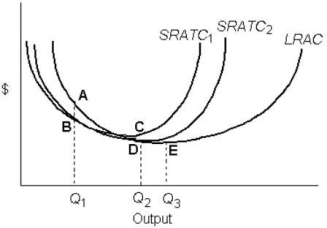
Refer to Figure 8- 2.Increasing returns to scale occur over the output range
A)beyond Q3 only.
B)Q1 to Q2 only.
C)0 to Q3 only.
D)Q2 to Q3 only.
E)0 to Q1 only.

Refer to Figure 8- 2.Increasing returns to scale occur over the output range
A)beyond Q3 only.
B)Q1 to Q2 only.
C)0 to Q3 only.
D)Q2 to Q3 only.
E)0 to Q1 only.

Unlock Deck
Unlock for access to all 127 flashcards in this deck.
Unlock Deck
k this deck
29
Which of the following statements most accurately makes the distinction between the long run and the very- long run with respect to the long- run average cost (LRAC)curve?
A)In the long run,the firm is moving along the existing LRAC curve,whereas in the very- long run,the LRAC curve is shifting down.
B)In the long run,the firm is moving along the existing LRAC curve,whereas in the very- long run,the LRAC curve is shifting up.
C)In the long run,the LRAC curve is shifting up,whereas in the very- long run the firm is moving along the existing LRAC curve.
D)In the long run,the LRAC curve is shifting down,whereas in the very- long run the firm is moving along the existing LRAC curve.
E)There is no distinction between the long run and the very- long run with respect to the LRAC curve.
A)In the long run,the firm is moving along the existing LRAC curve,whereas in the very- long run,the LRAC curve is shifting down.
B)In the long run,the firm is moving along the existing LRAC curve,whereas in the very- long run,the LRAC curve is shifting up.
C)In the long run,the LRAC curve is shifting up,whereas in the very- long run the firm is moving along the existing LRAC curve.
D)In the long run,the LRAC curve is shifting down,whereas in the very- long run the firm is moving along the existing LRAC curve.
E)There is no distinction between the long run and the very- long run with respect to the LRAC curve.

Unlock Deck
Unlock for access to all 127 flashcards in this deck.
Unlock Deck
k this deck
30
What information is displayed by an isoquant?
A)the whole set of technically efficient factor combinations that can produce varying levels of output
B)the whole set of technically efficient factor combinations that can produce a single level of output
C)various levels of output that can be produced with a fixed factor combination
D)the alternative factor combinations that require the same expenditure
E)various levels of output that can be produced with different factor combinations
A)the whole set of technically efficient factor combinations that can produce varying levels of output
B)the whole set of technically efficient factor combinations that can produce a single level of output
C)various levels of output that can be produced with a fixed factor combination
D)the alternative factor combinations that require the same expenditure
E)various levels of output that can be produced with different factor combinations

Unlock Deck
Unlock for access to all 127 flashcards in this deck.
Unlock Deck
k this deck
31
In the long run,a profit- maximizing firm produces any given level of output by choosing the production method that
A)equates the average cost per unit of all factors.
B)produces that output at the lowest possible cost.
C)is associated with a flat total cost curve.
D)maximizes the marginal product of all factors.
E)equates the marginal product of all factors.
A)equates the average cost per unit of all factors.
B)produces that output at the lowest possible cost.
C)is associated with a flat total cost curve.
D)maximizes the marginal product of all factors.
E)equates the marginal product of all factors.

Unlock Deck
Unlock for access to all 127 flashcards in this deck.
Unlock Deck
k this deck
32
Suppose a firm employs two inputs,X and Y,and that at their current levels of use MPX/PX > MPY/PY.To minimize the cost of production,the firm should hire
A)more input X only if its price decreases.
B)more input Y and less input X.
C)more input X and less input Y.
D)more input X only if its price increases.
E)more input Y only if its price falls.
A)more input X only if its price decreases.
B)more input Y and less input X.
C)more input X and less input Y.
D)more input X only if its price increases.
E)more input Y only if its price falls.

Unlock Deck
Unlock for access to all 127 flashcards in this deck.
Unlock Deck
k this deck
33
FIGURE 8- 1 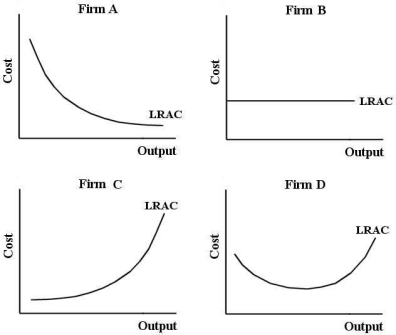
Refer to Figure 8- 1.Which of the four firms in the figure is displaying decreasing returns to scale at all output levels?
A)Firm A
B)Firm B
C)Firm C
D)Firm D
E)all firms are displaying increasing returns to scale

Refer to Figure 8- 1.Which of the four firms in the figure is displaying decreasing returns to scale at all output levels?
A)Firm A
B)Firm B
C)Firm C
D)Firm D
E)all firms are displaying increasing returns to scale

Unlock Deck
Unlock for access to all 127 flashcards in this deck.
Unlock Deck
k this deck
34
A change in the technique for producing an existing product is known as
A)process innovation.
B)an increase in productivity.
C)product innovation.
D)investment.
E)invention.
A)process innovation.
B)an increase in productivity.
C)product innovation.
D)investment.
E)invention.

Unlock Deck
Unlock for access to all 127 flashcards in this deck.
Unlock Deck
k this deck
35
The figure below shows the isocost lines facing a firm producing golf tees.
 FIGURE 8- 5
FIGURE 8- 5
Refer to Figure 8- 5.The firm that is facing the isocost lines as shown will minimize its cost of production of any given output level if it employs capital and labour such that the ratio of the marginal product of labour to the marginal product of capital (MPL/MPK)is equal to
A)2/5.
B)5.
C)Not able to determine from the information provided.
D)2.
E)5/2.
 FIGURE 8- 5
FIGURE 8- 5Refer to Figure 8- 5.The firm that is facing the isocost lines as shown will minimize its cost of production of any given output level if it employs capital and labour such that the ratio of the marginal product of labour to the marginal product of capital (MPL/MPK)is equal to
A)2/5.
B)5.
C)Not able to determine from the information provided.
D)2.
E)5/2.

Unlock Deck
Unlock for access to all 127 flashcards in this deck.
Unlock Deck
k this deck
36
FIGURE 8- 4 
Refer to Figure 8- 4.A firm that is producing an output of 1000 units will minimize its costs at point
A)A.
B)B.
C)C.
D)D.
E)halfway between B and D.

Refer to Figure 8- 4.A firm that is producing an output of 1000 units will minimize its costs at point
A)A.
B)B.
C)C.
D)D.
E)halfway between B and D.

Unlock Deck
Unlock for access to all 127 flashcards in this deck.
Unlock Deck
k this deck
37
A firm operates at its least- cost position for a given level of output by equating
A)the average product for each factor.
B)the marginal product of each factor.
C)the price of each input.
D)the total expenditure on each input.
E)the marginal product per dollar spent for each factor.
A)the average product for each factor.
B)the marginal product of each factor.
C)the price of each input.
D)the total expenditure on each input.
E)the marginal product per dollar spent for each factor.

Unlock Deck
Unlock for access to all 127 flashcards in this deck.
Unlock Deck
k this deck
38
FIGURE 8- 1 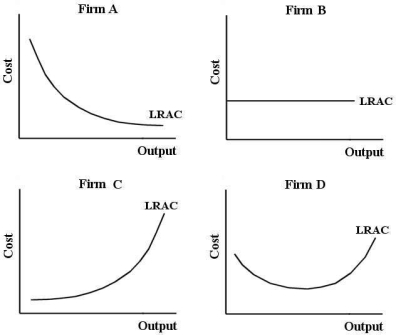
Refer to Figure 8- 1.For which of the four firms would the family of short- run average total cost curves lie below the LRAC?
A)Firm A
B)Firm B
C)Firm C
D)Firm D
E)none of the four firms

Refer to Figure 8- 1.For which of the four firms would the family of short- run average total cost curves lie below the LRAC?
A)Firm A
B)Firm B
C)Firm C
D)Firm D
E)none of the four firms

Unlock Deck
Unlock for access to all 127 flashcards in this deck.
Unlock Deck
k this deck
39
The figure below shows a family of cost curves for a firm.The subscripts 1,2,and 3 for the SRATC curves refer to different plant sizes.
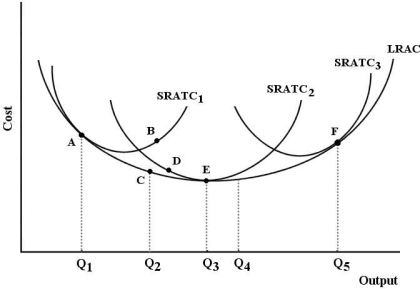 FIGURE 8- 3
FIGURE 8- 3
Refer to Figure 8- 3.If this firm is producing at point B,then
A)this firm is experiencing decreasing returns to scale.
B)it should employ more of its variable factors of production.
C)plant size 1 is optimal.
D)this firm is producing a level of output that is technically inefficient in the long run.
E)this firm could produce the same level of output at a lower cost with plant size 2.
 FIGURE 8- 3
FIGURE 8- 3Refer to Figure 8- 3.If this firm is producing at point B,then
A)this firm is experiencing decreasing returns to scale.
B)it should employ more of its variable factors of production.
C)plant size 1 is optimal.
D)this firm is producing a level of output that is technically inefficient in the long run.
E)this firm could produce the same level of output at a lower cost with plant size 2.

Unlock Deck
Unlock for access to all 127 flashcards in this deck.
Unlock Deck
k this deck
40
The following table shows the marginal products of capital (K)and labour (L)for various methods for Firm ABC to produce 1000 toys per day. TABLE 8- 2
-Refer to Table 8- 2.Suppose capital costs $80 per unit and labour costs $24 per unit.Which production method minimizes the cost of producing 1000 toys per day.
A)method F
B)method D
C)method E
D)method B
E)method C
-Refer to Table 8- 2.Suppose capital costs $80 per unit and labour costs $24 per unit.Which production method minimizes the cost of producing 1000 toys per day.
A)method F
B)method D
C)method E
D)method B
E)method C

Unlock Deck
Unlock for access to all 127 flashcards in this deck.
Unlock Deck
k this deck
41
A firm's long- run average cost curve
A)is horizontal in most situations.
B)is the boundary between attainable and unattainable cost levels,with known production technologies and given factor prices.
C)shows the relationship between marginal cost and output given that the economically most efficient method of production is employed.
D)is an envelope of short- run average variable cost curves.
E)shows the minimum cost of producing each possible level of output with a fixed factor.
A)is horizontal in most situations.
B)is the boundary between attainable and unattainable cost levels,with known production technologies and given factor prices.
C)shows the relationship between marginal cost and output given that the economically most efficient method of production is employed.
D)is an envelope of short- run average variable cost curves.
E)shows the minimum cost of producing each possible level of output with a fixed factor.

Unlock Deck
Unlock for access to all 127 flashcards in this deck.
Unlock Deck
k this deck
42
The figure below shows the isocost lines and the isoquant map for a firm producing golf tees.
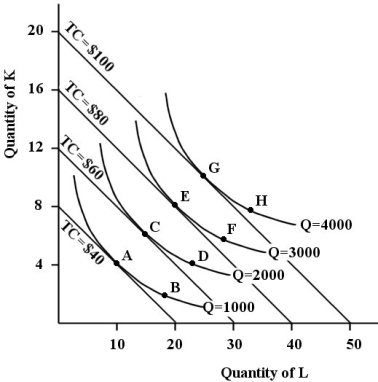 FIGURE 8- 6
FIGURE 8- 6
Refer to Figure 8- 6.At each of points A,C,E and G on the isoquant map we know that
A)the ratio of the marginal utilities of capital and labour is equal to the ratio of the prices of capital and labour.
B)the firm is at its cost- minimizing position for an output level of 4000 golf tees.
C)the firm can adjust its employment of factors to reduce its total cost,with output unchanged.
D)the firm has adjusted the factor prices to equate the ratio of marginal products of the factors.
E)the ratio of the marginal products of capital and labour is equal to the ratio of the prices of capital and labour.
 FIGURE 8- 6
FIGURE 8- 6Refer to Figure 8- 6.At each of points A,C,E and G on the isoquant map we know that
A)the ratio of the marginal utilities of capital and labour is equal to the ratio of the prices of capital and labour.
B)the firm is at its cost- minimizing position for an output level of 4000 golf tees.
C)the firm can adjust its employment of factors to reduce its total cost,with output unchanged.
D)the firm has adjusted the factor prices to equate the ratio of marginal products of the factors.
E)the ratio of the marginal products of capital and labour is equal to the ratio of the prices of capital and labour.

Unlock Deck
Unlock for access to all 127 flashcards in this deck.
Unlock Deck
k this deck
43
FIGURE 8- 2 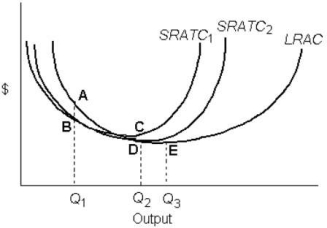
Refer to Figure 8- 2.Decreasing returns to scale occur over the output range
A)Q2 to Q3 only.
B)0 to Q3 only.
C)beyond Q3 only.
D)Q1 to Q2 only.
E)0 to Q1 only.

Refer to Figure 8- 2.Decreasing returns to scale occur over the output range
A)Q2 to Q3 only.
B)0 to Q3 only.
C)beyond Q3 only.
D)Q1 to Q2 only.
E)0 to Q1 only.

Unlock Deck
Unlock for access to all 127 flashcards in this deck.
Unlock Deck
k this deck
44
Assume a firm is using 6 units of capital and 6 units of labour to produce 6 baskets.Now it doubles both inputs resulting in a new total of 16 baskets being produced.This firm is experiencing
A)diseconomies of scale.
B)increasing costs.
C)decreasing returns to scale.
D)increasing returns to scale.
E)constant returns to scale.
A)diseconomies of scale.
B)increasing costs.
C)decreasing returns to scale.
D)increasing returns to scale.
E)constant returns to scale.

Unlock Deck
Unlock for access to all 127 flashcards in this deck.
Unlock Deck
k this deck
45
Suppose Farmer Smith hires 4 workers and leases 2 tractors and 15 hectares of farmland for one growing season,and produces 120 000 bushels of crop.The next year he hires 8 workers and leases 4 tractors and 30 hectares of farmland,and produces 210 000 bushels of crop.This firm (the farmer)is exhibiting returns to scale.
A)increasing
B)constant
C)variable
D)marginal
E)decreasing
A)increasing
B)constant
C)variable
D)marginal
E)decreasing

Unlock Deck
Unlock for access to all 127 flashcards in this deck.
Unlock Deck
k this deck
46
Canada has a much lower population density than does Japan.Therefore,the price of land (relative to the price of labour)is lower in Canada than in Japan.Consider a Canadian firm and a Japanese firm,both producing rice,both having access to the same technologies,and both striving to minimize costs.Now suppose that the relative price of land rises in Canada but remains the same in Japan.The effect on the use of inputs will be to
A)not change the land/labour ratio for either firm.
B)increase the land/labour ratio for both the Canadian and the Japanese firms.
C)increase the land/labour ratio for the Canadian firm.
D)decrease the land/labour ratio for the Canadian firm.
E)decrease the land/labour ratio for both the Canadian and the Japanese firms.
A)not change the land/labour ratio for either firm.
B)increase the land/labour ratio for both the Canadian and the Japanese firms.
C)increase the land/labour ratio for the Canadian firm.
D)decrease the land/labour ratio for the Canadian firm.
E)decrease the land/labour ratio for both the Canadian and the Japanese firms.

Unlock Deck
Unlock for access to all 127 flashcards in this deck.
Unlock Deck
k this deck
47
A cost- minimizing firm will increase its use of labour and decrease its use of capital when the
A)marginal product of capital,per dollar spent on capital,is less than the marginal product of labour,per dollar spent on labour.
B)average product of capital is higher than the average product of labour.
C)marginal product of capital is higher than the marginal product of labour.
D)marginal product of capital,per dollar spent on capital,is greater than the marginal product of labour,per dollar spent on labour.
E)total product of capital is higher than the total product of labour.
A)marginal product of capital,per dollar spent on capital,is less than the marginal product of labour,per dollar spent on labour.
B)average product of capital is higher than the average product of labour.
C)marginal product of capital is higher than the marginal product of labour.
D)marginal product of capital,per dollar spent on capital,is greater than the marginal product of labour,per dollar spent on labour.
E)total product of capital is higher than the total product of labour.

Unlock Deck
Unlock for access to all 127 flashcards in this deck.
Unlock Deck
k this deck
48
What is meant by the term "increasing returns to scale"?
A)it has the same meaning as increasing costs of production
B)output rises proportionately more than inputs,resulting in increasing per unit costs
C)output rises proportionately less than inputs,increasing per unit cost of production in the short run
D)it implies that the long- run average cost curve is shifting downward
E)output rises proportionately more than inputs,resulting in lower per unit costs in the long run
A)it has the same meaning as increasing costs of production
B)output rises proportionately more than inputs,resulting in increasing per unit costs
C)output rises proportionately less than inputs,increasing per unit cost of production in the short run
D)it implies that the long- run average cost curve is shifting downward
E)output rises proportionately more than inputs,resulting in lower per unit costs in the long run

Unlock Deck
Unlock for access to all 127 flashcards in this deck.
Unlock Deck
k this deck
49
Consider the short- run and long- run cost curves for a firm.If there is a fall in all factor prices faced by the firm,
A)it will move to a lower point on its existing long- run and short- run average cost curves.
B)there will be no change in the cost curves in the long run.
C)both the long- run and short- run average cost curves will shift downward.
D)it will move to a lower point on its existing long- run average cost curve only.
E)there will be a downward shift in the long- run average cost curve but not in the short- run average cost curve.
A)it will move to a lower point on its existing long- run and short- run average cost curves.
B)there will be no change in the cost curves in the long run.
C)both the long- run and short- run average cost curves will shift downward.
D)it will move to a lower point on its existing long- run average cost curve only.
E)there will be a downward shift in the long- run average cost curve but not in the short- run average cost curve.

Unlock Deck
Unlock for access to all 127 flashcards in this deck.
Unlock Deck
k this deck
50
Although capital is a variable factor in the long run,once chosen it becomes a fixed factor for a long time.A profit- maximizing firm must therefore select a method of production that is
A)adaptable to wide ranges of output over time.
B)economically efficient at current factor prices.
C)technologically advanced beyond methods currently used.
D)economically efficient at current factor prices and sufficiently flexible to adapt to changing factor prices over time.
E)labour intensive,as labour is always a variable factor.
A)adaptable to wide ranges of output over time.
B)economically efficient at current factor prices.
C)technologically advanced beyond methods currently used.
D)economically efficient at current factor prices and sufficiently flexible to adapt to changing factor prices over time.
E)labour intensive,as labour is always a variable factor.

Unlock Deck
Unlock for access to all 127 flashcards in this deck.
Unlock Deck
k this deck
51
Suppose that capital costs $6 per unit and labour costs $3 per unit.If the marginal product of capital is 12 and the marginal product of labour is 6,the cost- minimizing firm should
A)employ more of both capital and labour.
B)employ less of both capital and labour.
C)employ more capital and less labour.
D)employ less capital and more labour.
E)not change its current factor use.
A)employ more of both capital and labour.
B)employ less of both capital and labour.
C)employ more capital and less labour.
D)employ less capital and more labour.
E)not change its current factor use.

Unlock Deck
Unlock for access to all 127 flashcards in this deck.
Unlock Deck
k this deck
52
One hundred years ago,in North America and Europe it was commonplace for middle class households to employ housemaids.As you know,this is quite rare today.Most such households now have dishwashers,washing machines and dryers.What is an explanation of this change?
A)Over long periods of time,capital is always replaced by labour.
B)Households substituted away from a factor whose price was falling (labour)and toward a factor whose price was rising (capital).
C)The marginal product of labour was falling over time while the marginal product of capital was rising.
D)Households substituted away from an increasingly expensive factor (labour)and toward an increasingly inexpensive factor (capital).
E)Over long periods of time,labour is always replaced by capital.
A)Over long periods of time,capital is always replaced by labour.
B)Households substituted away from a factor whose price was falling (labour)and toward a factor whose price was rising (capital).
C)The marginal product of labour was falling over time while the marginal product of capital was rising.
D)Households substituted away from an increasingly expensive factor (labour)and toward an increasingly inexpensive factor (capital).
E)Over long periods of time,labour is always replaced by capital.

Unlock Deck
Unlock for access to all 127 flashcards in this deck.
Unlock Deck
k this deck
53
With respect to innovation,which of the following statements is true?
A)Government policy cannot influence the rate of innovation.
B)The principal incentive for innovation does not appear to be related to profits.
C)The utilization rate of existing plant and equipment and its durability are independent of the pace of innovation.
D)Innovation is exogenous to the economic system.
E)Innovation is often endogenous to the economic system.
A)Government policy cannot influence the rate of innovation.
B)The principal incentive for innovation does not appear to be related to profits.
C)The utilization rate of existing plant and equipment and its durability are independent of the pace of innovation.
D)Innovation is exogenous to the economic system.
E)Innovation is often endogenous to the economic system.

Unlock Deck
Unlock for access to all 127 flashcards in this deck.
Unlock Deck
k this deck
54
Which of the following is unlikely to be a source of increasing productivity?
A)substitution toward labour and away from capital (with constant technology)
B)better raw materials even if there are no changes in factor quantities or proportions
C)better- trained labour
D)increases in technological know- how
E)better organization of production
A)substitution toward labour and away from capital (with constant technology)
B)better raw materials even if there are no changes in factor quantities or proportions
C)better- trained labour
D)increases in technological know- how
E)better organization of production

Unlock Deck
Unlock for access to all 127 flashcards in this deck.
Unlock Deck
k this deck
55
The principle of substitution plays a central role in resource allocation because it demonstrates that
A)firms can use all factors of production interchangeably with no impact on their costs.
B)methods of producing the same commodity will not differ from one country to another.
C)prices will be relatively low for those factors for which demand is high relative to supply.
D)relative factor prices reflect relative scarcities of factors in the economy and so firms will find it profitable to make abundant use of relatively abundant factors.
E)firms will find it profitable to make abundant use of relatively scarce factors.
A)firms can use all factors of production interchangeably with no impact on their costs.
B)methods of producing the same commodity will not differ from one country to another.
C)prices will be relatively low for those factors for which demand is high relative to supply.
D)relative factor prices reflect relative scarcities of factors in the economy and so firms will find it profitable to make abundant use of relatively abundant factors.
E)firms will find it profitable to make abundant use of relatively scarce factors.

Unlock Deck
Unlock for access to all 127 flashcards in this deck.
Unlock Deck
k this deck
56
Suppose RioTintoAlcan is considering the construction of a new aluminum smelter in Northern Quebec,the operation of which requires a great deal of electricity.Suppose also that the price of electricity is predicted to rise significantly in the near future.As a result,the firm decides to embark on new research and development which leads to the development of a new production technique that uses less electricity per tonne of aluminum produced.This is an example of
A)short- run cost minimization.
B)short- run profit maximization.
C)innovation away from increases in factor prices.
D)long- run economies of scale.
E)the marginal rate of substitution between factors.
A)short- run cost minimization.
B)short- run profit maximization.
C)innovation away from increases in factor prices.
D)long- run economies of scale.
E)the marginal rate of substitution between factors.

Unlock Deck
Unlock for access to all 127 flashcards in this deck.
Unlock Deck
k this deck
57
If a firm is using labour and capital such that the MP of labour is two times the MP of capital,and the price of labour is four times the price of capital,the firm should in order to minimize its costs of producing its output.
A)decrease capital and increase labour
B)not alter its present factor mix
C)decrease both capital and labour
D)increase capital and decrease labour
E)increase both labour and capital
A)decrease capital and increase labour
B)not alter its present factor mix
C)decrease both capital and labour
D)increase capital and decrease labour
E)increase both labour and capital

Unlock Deck
Unlock for access to all 127 flashcards in this deck.
Unlock Deck
k this deck
58
The following table shows the marginal products of capital (K)and labour (L)for various methods for Firm ABC to produce 1000 toys per day. TABLE 8- 2
-Refer to Table 8- 2.Suppose capital costs $6 per unit and labour costs $4 per unit and the firm is employing production method A.How should this firm adjust its use of capital and labour to minimize costs?
A)employ less capital and more labour
B)employ more capital and less labour
C)employ less capital and less labour
D)employ more capital and more labour
E)There is insufficient information to know.
-Refer to Table 8- 2.Suppose capital costs $6 per unit and labour costs $4 per unit and the firm is employing production method A.How should this firm adjust its use of capital and labour to minimize costs?
A)employ less capital and more labour
B)employ more capital and less labour
C)employ less capital and less labour
D)employ more capital and more labour
E)There is insufficient information to know.

Unlock Deck
Unlock for access to all 127 flashcards in this deck.
Unlock Deck
k this deck
59
The figure below shows a family of cost curves for a firm.The subscripts 1,2,and 3 for the SRATC curves refer to different plant sizes.
 FIGURE 8- 3
FIGURE 8- 3
Refer to Figure 8- 3.Should this profit- maximizing firm ever consider moving from point E (output level Q3 on SRATC2)to point F (output level Q5 on SRATC3)?
A)Yes,because the firm can take advantage of economies of scale.
B)No,because they are already producing at their lowest possible cost at point E.
C)Yes,because SRATC3 is the optimal plant size for this firm.
D)Yes,if the product price rises enough to lead the firm to expand to plant size 3.
E)No,because producing at point F implies a higher cost per unit of output.
 FIGURE 8- 3
FIGURE 8- 3Refer to Figure 8- 3.Should this profit- maximizing firm ever consider moving from point E (output level Q3 on SRATC2)to point F (output level Q5 on SRATC3)?
A)Yes,because the firm can take advantage of economies of scale.
B)No,because they are already producing at their lowest possible cost at point E.
C)Yes,because SRATC3 is the optimal plant size for this firm.
D)Yes,if the product price rises enough to lead the firm to expand to plant size 3.
E)No,because producing at point F implies a higher cost per unit of output.

Unlock Deck
Unlock for access to all 127 flashcards in this deck.
Unlock Deck
k this deck
60
Consider the short- run and long- run cost curves for a firm.If factor prices decrease,
A)there will be no change in the cost curves in the long run.
B)the firm will move down along both its long- run and short- run average cost curves.
C)both the long- run and short- run average cost curves will shift downward.
D)the firm will move down along its long- run average cost curve only.
E)there will be a downward shift in the long- run average cost curve but not in the short- run average cost curve.
A)there will be no change in the cost curves in the long run.
B)the firm will move down along both its long- run and short- run average cost curves.
C)both the long- run and short- run average cost curves will shift downward.
D)the firm will move down along its long- run average cost curve only.
E)there will be a downward shift in the long- run average cost curve but not in the short- run average cost curve.

Unlock Deck
Unlock for access to all 127 flashcards in this deck.
Unlock Deck
k this deck
61
Which of the following cost curves demonstrate increasing returns to scale?
A)a vertical long- run average cost curve
B)an upward- sloping long- run average cost curve
C)returns to scale have nothing to do with the shape of the long- run average cost curve
D)a horizontal long- run average cost curve
E)a downward- sloping long- run average cost curve
A)a vertical long- run average cost curve
B)an upward- sloping long- run average cost curve
C)returns to scale have nothing to do with the shape of the long- run average cost curve
D)a horizontal long- run average cost curve
E)a downward- sloping long- run average cost curve

Unlock Deck
Unlock for access to all 127 flashcards in this deck.
Unlock Deck
k this deck
62
FIGURE 8- 4 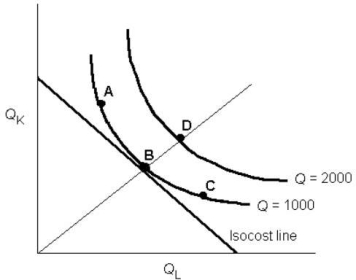
Refer to Figure 8- 4.The firm is initially producing 2000 units and minimizing its production cost at point D.Suppose the prices of capital and labour each rise by 10%.If the firm wishes to continue producing the same level of output it will
A)remain at point D.
B)move toward point A.
C)move to the right of point D.
D)move toward point B.
E)move toward point C.

Refer to Figure 8- 4.The firm is initially producing 2000 units and minimizing its production cost at point D.Suppose the prices of capital and labour each rise by 10%.If the firm wishes to continue producing the same level of output it will
A)remain at point D.
B)move toward point A.
C)move to the right of point D.
D)move toward point B.
E)move toward point C.

Unlock Deck
Unlock for access to all 127 flashcards in this deck.
Unlock Deck
k this deck
63
Canada has a much lower population density than does Japan.Therefore,the price of land (relative to the price of labour)is lower in Canada than in Japan.Consider a Canadian firm and a Japanese firm,both producing rice,both having access to the same technologies,and both striving to minimize their costs.The Canadian firm will use the two inputs,land and labour,in such a way that its land/labour ratio is
A)lower than that of the Japanese firm.
B)indeterminate as there is insufficient information to know.
C)equal to that of the Japanese firm.
D)equal to one.
E)higher than that of the Japanese firm.
A)lower than that of the Japanese firm.
B)indeterminate as there is insufficient information to know.
C)equal to that of the Japanese firm.
D)equal to one.
E)higher than that of the Japanese firm.

Unlock Deck
Unlock for access to all 127 flashcards in this deck.
Unlock Deck
k this deck
64
FIGURE 8- 2 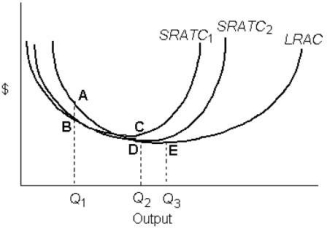
Refer to Figure 8- 2.In the long run,the lowest- cost level of output achievable by this firm is
A)Q1.
B)Q3.
C)Q2.
D)not shown in the diagram

Refer to Figure 8- 2.In the long run,the lowest- cost level of output achievable by this firm is
A)Q1.
B)Q3.
C)Q2.
D)not shown in the diagram

Unlock Deck
Unlock for access to all 127 flashcards in this deck.
Unlock Deck
k this deck
65
Consider the short- run and long- run cost curves for a firm.If there is an improvement in the firm's technology,
A)there will be a downward shift in the long- run average cost curve but not in the short- run average cost curve.
B)the firm will move to a lower point on both its long- run and short- run average cost curves.
C)the firm will move to a lower point on its long- run average cost curve only.
D)there will be no change in the cost curves in the long run.
E)both the long- run and short- run average cost curves will shift downward.
A)there will be a downward shift in the long- run average cost curve but not in the short- run average cost curve.
B)the firm will move to a lower point on both its long- run and short- run average cost curves.
C)the firm will move to a lower point on its long- run average cost curve only.
D)there will be no change in the cost curves in the long run.
E)both the long- run and short- run average cost curves will shift downward.

Unlock Deck
Unlock for access to all 127 flashcards in this deck.
Unlock Deck
k this deck
66
Suppose a firm experiences decreasing returns to scale.This is shown graphically by
A)a downward- sloping long- run marginal- cost curve.
B)an increasing marginal product curve.
C)a horizontal long- run average cost curve.
D)a downward- sloping long- run average cost curve.
E)an upward- sloping long- run average cost curve.
A)a downward- sloping long- run marginal- cost curve.
B)an increasing marginal product curve.
C)a horizontal long- run average cost curve.
D)a downward- sloping long- run average cost curve.
E)an upward- sloping long- run average cost curve.

Unlock Deck
Unlock for access to all 127 flashcards in this deck.
Unlock Deck
k this deck
67
Which of the following paired concepts are equivalent to each other?
A)decreasing costs; economies of scale
B)constant costs; economies of scale
C)increasing returns; diseconomies of scale
D)decreasing returns; decreasing costs
E)increasing returns; increasing costs
A)decreasing costs; economies of scale
B)constant costs; economies of scale
C)increasing returns; diseconomies of scale
D)decreasing returns; decreasing costs
E)increasing returns; increasing costs

Unlock Deck
Unlock for access to all 127 flashcards in this deck.
Unlock Deck
k this deck
68
Suppose that capital costs $100 per unit and labour costs $40 per unit.If the marginal product of capital is 200 and the marginal product of labour is 60,a cost- minimizing firm should
A)employ more of both capital and labour.
B)employ less of both capital and labour.
C)not change its current factor use.
D)employ less capital and more labour.
E)employ more capital and less labour.
A)employ more of both capital and labour.
B)employ less of both capital and labour.
C)not change its current factor use.
D)employ less capital and more labour.
E)employ more capital and less labour.

Unlock Deck
Unlock for access to all 127 flashcards in this deck.
Unlock Deck
k this deck
69
Suppose that capital costs $6 per unit and labour costs $3 per unit.If the marginal product of capital is 3 and the marginal product of labour is 6,the cost- minimizing firm should
A)employ more of both capital and labour.
B)employ less of both capital and labour.
C)employ more capital and less labour.
D)employ less capital and more labour.
E)not change its current factor use.
A)employ more of both capital and labour.
B)employ less of both capital and labour.
C)employ more capital and less labour.
D)employ less capital and more labour.
E)not change its current factor use.

Unlock Deck
Unlock for access to all 127 flashcards in this deck.
Unlock Deck
k this deck
70
Assume a firm is using 10 units of capital and 10 units of labour to produce 10 widgets per hour.By doubling both inputs the result is a doubling of output.This firm is experiencing
A)diseconomies of scale.
B)decreasing returns.
C)increasing costs.
D)economies of scale.
E)constant returns to scale.
A)diseconomies of scale.
B)decreasing returns.
C)increasing costs.
D)economies of scale.
E)constant returns to scale.

Unlock Deck
Unlock for access to all 127 flashcards in this deck.
Unlock Deck
k this deck
71
Movement from one point to another along an isoquant implies a change in
A)money income.
B)output levels,holding factor combinations constant.
C)the level of output,independent of what happens to factor combinations.
D)factor combinations,holding output constant.
E)product prices.
A)money income.
B)output levels,holding factor combinations constant.
C)the level of output,independent of what happens to factor combinations.
D)factor combinations,holding output constant.
E)product prices.

Unlock Deck
Unlock for access to all 127 flashcards in this deck.
Unlock Deck
k this deck
72
Suppose that capital costs $10 per unit and labour costs $4 per unit.If the marginal product of capital is 50 and the marginal product of labour is 50,the firm should in order to minimize its costs of producing its output.
A)employ more capital and less labour
B)not change its current factor use
C)employ less capital and labour
D)employ less capital and more labour
E)employ more capital and labour
A)employ more capital and less labour
B)not change its current factor use
C)employ less capital and labour
D)employ less capital and more labour
E)employ more capital and labour

Unlock Deck
Unlock for access to all 127 flashcards in this deck.
Unlock Deck
k this deck
73
Which of the following statements concerning long- run and short- run cost curves is correct?
A)Both the long- run and short- run average cost curves show the lowest cost of producing any output when all factors are variable.
B)The minimum point of the long- run average cost curve will correspond to the minimum point on a single short- run average cost curve.
C)The short- run average cost curve is tangent to the long- run average cost curve for all levels of output of the fixed factor.
D)The long- run average cost curve envelops a whole family of short- run marginal cost curves.
E)A short- run average cost curve can fall below the long- run average cost curve.
A)Both the long- run and short- run average cost curves show the lowest cost of producing any output when all factors are variable.
B)The minimum point of the long- run average cost curve will correspond to the minimum point on a single short- run average cost curve.
C)The short- run average cost curve is tangent to the long- run average cost curve for all levels of output of the fixed factor.
D)The long- run average cost curve envelops a whole family of short- run marginal cost curves.
E)A short- run average cost curve can fall below the long- run average cost curve.

Unlock Deck
Unlock for access to all 127 flashcards in this deck.
Unlock Deck
k this deck
74
By expressing the cost- minimizing condition as MPK/MPL = PK/PL,we are able to see
A)that the firm is producing at a lower cost if the left- hand side of the equation is greater than the right- hand side.
B)that the capital- labour ratio is fixed.
C)how the firm determines its profit- maximizing output.
D)that the ratio of factor prices is constant over time.
E)how the firm can adjust the marginal products of the factors of production to the prices of the factors given by the market.
A)that the firm is producing at a lower cost if the left- hand side of the equation is greater than the right- hand side.
B)that the capital- labour ratio is fixed.
C)how the firm determines its profit- maximizing output.
D)that the ratio of factor prices is constant over time.
E)how the firm can adjust the marginal products of the factors of production to the prices of the factors given by the market.

Unlock Deck
Unlock for access to all 127 flashcards in this deck.
Unlock Deck
k this deck
75
Increasing returns to scale for a firm is shown graphically by
A)an upward- sloping long- run average cost curve.
B)a vertical long- run average cost curve.
C)a horizontal long- run average cost curve.
D)a downward- sloping long- run average cost curve.
E)None of the above; returns to scale have nothing to do with the shape of the long- run average cost curve.
A)an upward- sloping long- run average cost curve.
B)a vertical long- run average cost curve.
C)a horizontal long- run average cost curve.
D)a downward- sloping long- run average cost curve.
E)None of the above; returns to scale have nothing to do with the shape of the long- run average cost curve.

Unlock Deck
Unlock for access to all 127 flashcards in this deck.
Unlock Deck
k this deck
76
The long- run average cost (LRAC)curve shows
A)what happens to the fixed costs in the long run.
B)the same as the short- run average cost curve.
C)the lowest unit cost at which the firm can produce a given output.
D)the operation of the law of diminishing returns.
E)the highest unit costs of producing a given output.
A)what happens to the fixed costs in the long run.
B)the same as the short- run average cost curve.
C)the lowest unit cost at which the firm can produce a given output.
D)the operation of the law of diminishing returns.
E)the highest unit costs of producing a given output.

Unlock Deck
Unlock for access to all 127 flashcards in this deck.
Unlock Deck
k this deck
77
FIGURE 8- 4 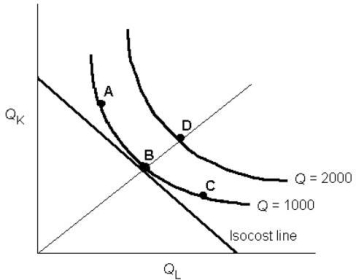
Refer to Figure 8- 4.The firm is initially minimizing the cost of producing 1000 units of output.Suppose the factor prices then change such that the price of capital (K)falls and the price of labour (L)rises.If the firm decides to leave its output unchanged,it will now move toward the point
A)A.
B)B.
C)C.
D)D.
E)Unknown as there is insufficient information to know

Refer to Figure 8- 4.The firm is initially minimizing the cost of producing 1000 units of output.Suppose the factor prices then change such that the price of capital (K)falls and the price of labour (L)rises.If the firm decides to leave its output unchanged,it will now move toward the point
A)A.
B)B.
C)C.
D)D.
E)Unknown as there is insufficient information to know

Unlock Deck
Unlock for access to all 127 flashcards in this deck.
Unlock Deck
k this deck
78
Suppose that capital costs $8 per unit and labour costs $4 per unit.For a profit- maximizing firm operating at its optimal factor mix,if the marginal product of capital is 60,the marginal product of labour must be
A)120.
B)10.
C)90.
D)20.
E)30.
A)120.
B)10.
C)90.
D)20.
E)30.

Unlock Deck
Unlock for access to all 127 flashcards in this deck.
Unlock Deck
k this deck
79
A short- run average total cost curve will touch the long- run average cost curve at a level of output only
A)where the short- run cost curve is downward sloping.
B)by coincidence.
C)when the quantity of the fixed factor being employed is at the optimal level for that level of output.
D)where the short- run cost curve is upward sloping.
E)where the short- run cost curve is downward- sloping and the quantity of the fixed factor is optimal.
A)where the short- run cost curve is downward sloping.
B)by coincidence.
C)when the quantity of the fixed factor being employed is at the optimal level for that level of output.
D)where the short- run cost curve is upward sloping.
E)where the short- run cost curve is downward- sloping and the quantity of the fixed factor is optimal.

Unlock Deck
Unlock for access to all 127 flashcards in this deck.
Unlock Deck
k this deck
80
Suppose a shipping company employs 2000 workers,operates 400 delivery trucks and makes 1.5 million domestic shipments in one year.The next year they increase their workforce to 3000 workers,operate 600 trucks and make 2.8 million domestic shipments in one year.This firm is exhibiting returns to scale.
A)increasing
B)marginal
C)decreasing
D)constant
E)variable
A)increasing
B)marginal
C)decreasing
D)constant
E)variable

Unlock Deck
Unlock for access to all 127 flashcards in this deck.
Unlock Deck
k this deck



